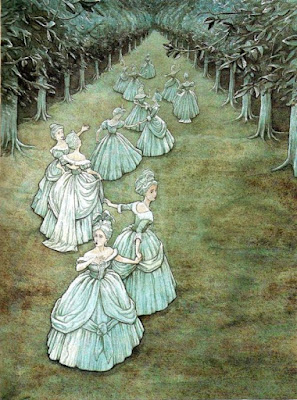Enchanted Ballrooms and Danced Out Shoes
Found via Pinterest
I've always been an avid reader (surprise, surprise!). Fairytales captured my attention at young age thanks to Disney movies initially and then my discovery of Andrew Lang's series at our public library. When I was trying to decide whether or not I wanted to go to grad school, I enrolled in a split level class on fairytales and folklore while working as a teacher part time. I ended up writing my final paper on "The Twelve Dancing Princesses" by the Grimm brothers. What was unique about this paper was that it had to be paired with a creative re-telling. I re-wrote the story with a more feminist ending and then wrote a 10 page paper giving context and analysis. I used this paper as one of my writing samples for my grad school application.
"The Twelve Dancing Princesses" has always been a fascinating story to me in part because of how these sisters sneak out of their castle at night and dance the night away, ruining many pairs of shoes in the process. Out of frustration, their father, the king, offers up a reward if anyone can discover how these shoes are being destroyed. The reward is of course marriage. Many try and fail and are executed. Finally an old soldier, with the help of a magic cloak, is able to follow them and discover how they sneak out of the castle and go to an enchanted place where they dance all night. He is rewarded with a princess for a wife, of course! There is no real insight given into what the princesses' motivations are or how they feel about their father marrying them off (something I definitely addressed in my re-telling).
This fairytale is classified in the ATU index as #306: Supernatural Opponents. For more information about the ATU index, check out the wikipedia page here. This classification got me thinking about other examples of dancing and enchantment--chiefly in the movie Labyrinth and in the book/miniseries Jonathan Strange and Mr. Norrell. In both works there are sinister, otherworldly men who keep women trapped in an enchanted dance or ballroom. And in both instances, the women are the ones who take action and free themselves.
Found here
In Labyrinth, Sarah must save her baby brother after wishing him to the goblins out of anger. She is thwarted at nearly every turn by Jareth, the Goblin king, who wishes to keep her brother and ensnare her as well. She manages to gather a ragtag group of friends who help her on her quest. She is poisoned with a peach, given to her by Hoggle (against his will) and hallucinates this elaborate ballroom scene where she dances with David Bowie (dream come true, to be honest). Here's a link to this scene on Youtube. Eventually, she sees a clock, realizes that she is running out of time to save Toby, and breaks free.
In Jonathan Strange and Mr. Norrell, Lady Pole is forced to dance all night long by the Thistle-haired Gentleman after Mr. Norrell makes an ill-fated bargain with him to bring her back to life. By day she is exhausted and lifeless, unable to describe the reason for her fatigue because of an enchantment. Every time she tries, her words become nonsensical. Later on, Jonathan Strange's wife is kidnapped and trapped in Lost Hope. Lady Pole helps her escape, much to the fury of the Thistle-haired Gentleman (who is a fairy).
I am not sure I have much more to say--at least nothing incredibly illuminating or smart. I am simply fascinated by both the "supernatural opponent" story type and how dancing is weaponized in these stories. Historically speaking, dance can be used to communicate what cannot be spoken and it can also be a tool for social interaction (think Jane Austen). Here, men utilize it to trap women and women follow the steps until they can break free. With my re-telling of the Grimm fairytale, I used dance as way for the princesses to gain autonomy.
If you are interested in further exploration, here's a link to an encyclopedia entry with a list of variants on the Grimm story.





I really enjoy how a number of your essays on this blog examine some shared feature between literature and movies, and do so in a way that provides inviting analysis in a matter of fact way. I look forward to reading more of your work.
ReplyDelete